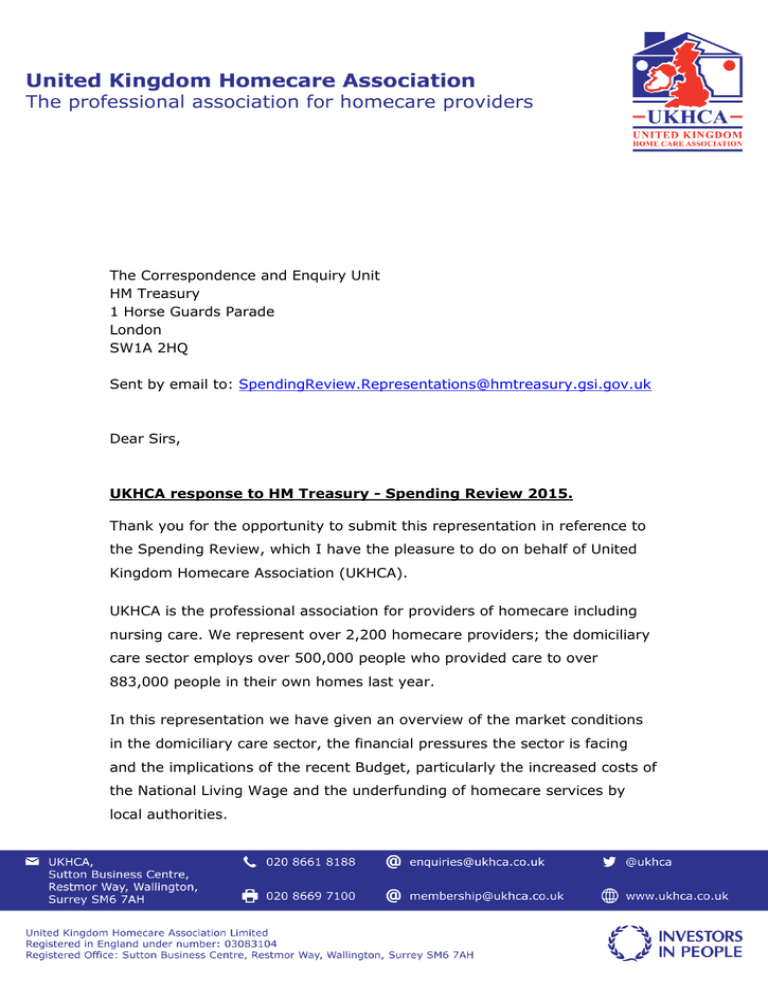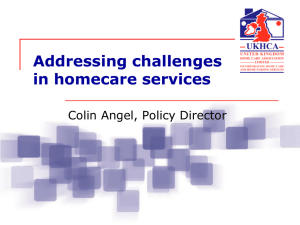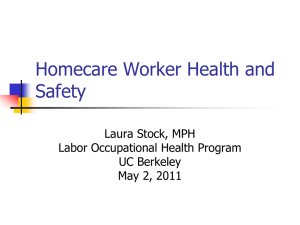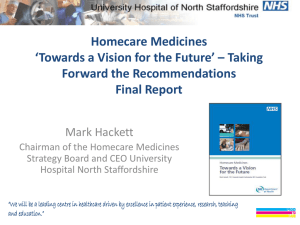The Correspondence and Enquiry Unit HM Treasury 1 Horse Guards Parade
advertisement

The Correspondence and Enquiry Unit HM Treasury 1 Horse Guards Parade London SW1A 2HQ Sent by email to: SpendingReview.Representations@hmtreasury.gsi.gov.uk Dear Sirs, UKHCA response to HM Treasury - Spending Review 2015. Thank you for the opportunity to submit this representation in reference to the Spending Review, which I have the pleasure to do on behalf of United Kingdom Homecare Association (UKHCA). UKHCA is the professional association for providers of homecare including nursing care. We represent over 2,200 homecare providers; the domiciliary care sector employs over 500,000 people who provided care to over 883,000 people in their own homes last year. In this representation we have given an overview of the market conditions in the domiciliary care sector, the financial pressures the sector is facing and the implications of the recent Budget, particularly the increased costs of the National Living Wage and the underfunding of homecare services by local authorities. If you have any questions arising from the points made in this representation please do not hesitate to contact me. Yours sincerely, Colin Angel, Policy Director Tel: 020 8661 8188 Email: colin.angel@ukhca.co.uk Alternative formats: If you would prefer to receive this representation in another accessible format, including e-text, ‘clear print’, large print or audio cassette, please contact us on 020 8288 5291 or accessibility@ukhca.co.uk. Page 2 of 31 Key facts The state funded homecare sector is running at a substantial deficit, and we believe that insufficient care is commissioned to meet the actual needs of the population. Grossly underfunded care will lead to market instability and large scale market exit. This will impact greatly upon older and disabled people who use homecare services, and will place further demand side pressure upon the NHS. 883,000 people received homecare over the financial year 2013/14. There are approximately 1.6 million adults with unmet social care needs. 500,000 people are employed as careworkers in the domiciliary care sector. 86% of the workforce are aged 25 years or more and will be entitled to the new National Living Wage from April 2016. Homecare is generally purchased by councils in units of one hour, or part thereof. The recommended minimum price for homecare calculated by UKHCA at the 2014/15 national minimum wage rate is £15.74 per hour. Our calculation is that the minimum price for homecare will increase to £16.70 per hour when the National Living Wage is introduced in April 2016. Responding to questions under the Freedom of Information Act, local councils (and the Health and Social Care Trusts in Northern Ireland) admitted that the average price paid for homecare was £13.66 per hour. UKHCA estimate that by the end of this financial year the state funded homecare sector will run at a deficit of £514 million per annum. We predict that this figure will increase to £753 million during the financial year 2016/17 when the National Living Wage is introduced. In a recent survey conducted 10 medium to large providers, delivering 36 million hours of homecare per year from 398 locations: o Local authority business accounted for 83.1% of the total hours of care delivered. o Providers’ EBITDA margin on current local authority business ranges from 2.0% to 8.1% (median 4.1%). o From April 2015, these providers predicted EBITDA falling to -5.3% to 3.0% (median 1.3%), unless they received additional funding from councils, reduce their loss-making contract business or find further efficiencies. o We believe that large organisations operating in the homecare sector should be able to expect an EBITDA margin in the region of 7.5%, that they will consider closing un-profitable branches at 5% and exit from the state-funded market at 3%. o Expectations of smaller providers will generally be at higher EBITDA margins than their larger competitors. We estimate that the National Living Wage will add £0.93 per hour to the wage costs of front-line homecare workers, equivalent to an additional wage bill of £303 million in 2016-17. On a sample day in June 2015 there were 810 people in hospital with a delayed discharge awaiting homecare. This is an 81% increase compared to the sample day in February 2014. Adequately funded homecare is part of the solution to delayed discharges. Page 4 of 31 In the financial year 2013/14 the NHS spent a total of £1.05 billion on Non-elective Inpatient Excess Bed Days. This represents a unit cost of £275 per day. UKHCA estimate that in June 2015 the NHS spent £222,750 per day on excess bed days for people awaiting homecare. This represents an annual expenditure for the financial year 2015/16 of £80 million. Annual NHS expenditure on delayed discharges for people awaiting homecare is equivalent to 4.8 million hours of fully funded homecare at National Living Wage rates. Page 5 of 31 Introduction Homecare has the capacity to support older and disabled people to live at home in comfort and dignity while taking an active role in their community. It also supports family carers to remain in employment. Last year more than 883,000 people benefited from state-funded homecare in the UK. There are over 500,000 people employed as careworkers in the homecare sector, they are our most valuable resource. Careworkers deliver vital support, care and companionship to people living with care and support needs. Homecare offers its workforce a rewarding career and a flexible working life. In this respect the homecare workforce is invaluable to the economy as whole, the sector can help reduce the uptake of out-of-work benefits and reduce the nation’s unemployment rate. However, we are concerned that the persistent underfunding of homecare could in the short term have catastrophic consequences for the people who use services, their family, the homecare workforce and the efficiency of the NHS. We believe that this submission demonstrates the depth of underfunding in the homecare sector, and evidences the assertion that underfunding homecare is in fact an inefficient use of public money, supported through the spending review. Page 6 of 31 The deficient funding of frontline homecare Local authorities are the largest purchasers of homecare in the UK, in the financial year 2013/14 local authorities purchased approximately 247 million hours of homecare from independent and voluntary sector providers. Local authorities purchase homecare in hourly units or parts thereof, UKHCA have costed the minimum hourly price for domiciliary care at the current national minimum wage at £15.74 per hour.1 This accounts for: Payment for the worker’s contact time; Payment for the worker’s travel time; Employer’s National Insurance Contributions; Worker’s holiday pay; Training and supervision time; Pension contributions; Mileage payments; Costs of running the business; and A 3% profit margin or surplus. Separate research conducted by UKHCA found that the average price paid for homecare by local authorities (and health and social care trusts in Northern Ireland) in the UK is £13.66 per hour.2 1 Please see; UKHCA A Minimum Price for Homecare, Version 3.0. Available at: http://www.ukhca.co.uk/downloads.aspx?ID=434 2 Please see; UKHCA The Homecare Deficit: A report on the funding of older people’s homecare across the United Kingdom. Available at: http://www.ukhca.co.uk/downloads.aspx?ID=458 Page 7 of 31 £13.66 £15.74 £16.70 Average price paid by local authorities (and health and social care trusts in Northern Ireland) compared to Minimum Wage and Living Wage rates Average price paid Price needed to meet 2014/15 National Minimum Wage Price needed to meet National Living Wage Figure 1 Average price paid by local authorities and health and social care trusts in Northern Ireland compared to Minimum Wage and Living Wage rates This represents a deficit for the financial year 2013/14 of £514 million. Assuming all other market conditions remain constant, this deficit will increase to at least £753 million over the financial year 2016/17 when the National Living Wage is introduced. UKHCA have calculated that the minimum price for homecare from April 2016 when the National Living Wage is introduced will be £16.70 per hour. (𝐴𝑐𝑡𝑢𝑎𝑙 𝑝𝑟𝑖𝑐𝑒 𝑝𝑎𝑖𝑑 − 𝑀𝑖𝑛𝑖𝑚𝑢𝑚 𝑝𝑟𝑖𝑐𝑒 𝑛𝑒𝑒𝑑𝑒𝑑) × 𝐴𝑛𝑛𝑢𝑎𝑙 ℎ𝑜𝑢𝑟𝑠 𝑜𝑓 𝑐𝑎𝑟𝑒 = 𝐴𝑛𝑛𝑢𝑎𝑙 𝐷𝑒𝑓𝑖𝑐𝑖𝑡 𝑜𝑟 𝑆𝑢𝑟𝑝𝑙𝑢𝑠 (£) (£13.66 − £16.70) × 247 𝑚𝑖𝑙𝑙𝑖𝑜𝑛 = £753 𝑚𝑖𝑙𝑙𝑖𝑜𝑛 𝑑𝑒𝑓𝑖𝑐𝑖𝑡 The deficit severely threatens market stability and diminishes capacity. This has a negative impact on the health and wellbeing of people who use homecare services and places unnecessary demand side pressure on the NHS. Page 8 of 31 If this deficit is not addressed by Government market stability will suffer and the quantity of homecare will diminish. However the size of the deficit is likely to increase given the fact that local authority adult social care budgets are set for further spending reductions. The Association of Directors of Adults Social Services (ADASS) have forecast that councils in England will need to find savings of £1.1 billion over 2015/16 from their adult social care budget. Compared to £850 million in 2014/15. This represents a 29% increase in planned savings for 2015/16 compared to the previous financial year. Since 2010 ADASS have tracked the cumulative total of cuts to local authority net adult social care budgets in England, this figure has now reached £4.6 billion.3 Similarly, the finance ministers in the devolved administrations have issued a joint public warning that further cuts to public spending would have a damaging effect on the quality and sufficiency of public services. The letter read: “The three devolved administrations share the view that the UK government’s ongoing austerity plans, reflected in both the in-year spending reductions announced on 4 June and in the Summer Budget, continue to reduce public spending in the UK too fast and too far, and present unnecessary risks to our public services.”4 3 ADASS, Budget Survey 2015, Final Report, p. 7. Available at: http://www.adass.org.uk/uploadedFiles/adass_content/policy_networks/resources/Key_ documents/ADASS%20Budget%20Survey%202015%20Report%20FINAL.pdf 4 Please see, Scottish Government Press Release, Finance Ministers Trilateral. Available at: http://news.scotland.gov.uk/News/Finance-Ministers-Trilateral-1bcc.aspx Page 9 of 31 UKHCA have seen a rapid increase in the number of homecare providers who intend to handback substantial volumes of state funded homecare packages on the grounds of inadequate fees. Handing back large numbers of care packages increases the workload and costs of local authority commissioning and procurement services as each package of care must be reassigned to an alternative care provider. In the case of a significant planned market exit or provider failure the local authority will have to conduct an entire re-procurement exercise. Page 10 of 31 Market stability In a recent letter to the Chancellor, of 27th July 2015,5 we raised our concerns that the persistent underfunding of homecare across the UK, compounded by the introduction of the National Living Wage in April 2016, would undermine the long term sustainability of the care market nationwide and enforce structural change without sufficient funding. We have identified that the state funded homecare sector will run at a deficit of £753 million over the financial year 2016/17 unless adequate funding is found, and responsible commissioning practices are guaranteed within local authorities. This is not sustainable and is likely to lead to market exit by providers of varying sizes and capacity. Market exit by any homecare provider would impact most acutely upon the people who use homecare services. Reduced market capacity would also transfer considerable demand side pressure onto the NHS. We surveyed 10 independent and voluntary sector organisations, representing medium to large scale providers, across 398 branches and franchises and employing a combined total of 40,029 workers. The organisations provided a combined total of 691,322 hours of care per week, equivalent to 36 million hours of care per year. These organisations represent medium and large-scale providers and were selected because they could provide a wide sample of statutory-sector business across the UK and, as larger providers, are likely to benefit from economies of 5 UKHCA, Letter to the Chancellor, July 2015. Available at: http://www.ukhca.co.uk/downloads.aspx?ID=473 Page 11 of 31 scale which may enable them to trade more efficiently in what is typically 'high volume, low margin' business available from local authorities. There is evidence of high dependence of these businesses on local authoritycommissioned services, with 83% (574,513 hours per week) of all care delivered purchased by councils. The extreme commercial sensitivity of the data we requested means that we are only able to report the following financial and contractual information in aggregated and anonymised format. The providers currently operate on a gross margin between 21.2% and 42.2% (median 30.4%). This would support UKHCA's assumption of 30% gross margin used in our calculation of the Minimum Price for Homecare at current statutory wage rates. Gross margin covers the costs of running the business and the profit/surplus element (if any). At present, providers calculated their EBITDA margin on local authority business ranged from 2.0% to 8.1% (median 4.1%). On the assumption that providers do not receive uplifts on current local authority business and are unable to make additional cost savings (including handing-back business to councils or reducing staff numbers) the organisations estimated that, following the introduction of the National Living Wage in April 2016, their EBITDA margin on local authority business would range from -5.3% to 3.0% (median 1.3%). We note that one provider stated that they already operate on negative EBITDA margin and would be further affected by the introduction of the National Living Wage. Our survey design does not enable us to analyse the reason for the Page 12 of 31 organisation being able to do so in a sustained way. We assume that it is the result of cross-subsidy from other revenue streams, which may or may not be from homecare (or indeed from social care) services. As a result, their figures have not been included in the above calculations. We believe that the following summary of EBITDA margins within the homecare sector provide reasonable working assumptions for likely industry expectations and behaviours: Large provider Small provider Multi-branch, operating >10,000 hours per week Single branch, operating c2,000 hours per week Industry expectation: 7.5% 10.0% Providers consider closing un-profitable branches: 5.0% 8.0% Potential exit from state-funded market: 3.0% 7.0% We asked the providers in our survey to provide us with examples of contracts which they believed were at risk of becoming commercially unsustainable because of the rates paid by local authorities. 54 examples of contracts at risk were provided, totalling 93,633 hours of care per week. Asked what they would do if the authority did not increase rates to cover the additional costs of the National Living Wage (and the provider was unable to make additional cost efficiencies), the providers told us that they were likely to terminate at least 33 of those contracts, totalling 55,125 hours of care per week. Page 13 of 31 While this is an incomplete sample, and cannot be generalised-up to present national figures for comparative purposes, the risk to market stability in the North East, North West and East and West Midlands in our data is stark, as are the number of service users likely to be affected and the resources that local councils would need to employ in order to re-provide services in the event of market withdrawal: Government region Weekly hours at risk Contracts at risk 23,025 7 North West 7,850 7 East Midlands 7,600 5 West Midlands 6,400 5 Yorkshire & Humber 3,400 2 Northern Ireland 3,150 1 London 1,200 2 Wales 1,100 2 South West 1,000 1 400 1 55,125 33 North East East of England Grand total We offer the following extracts from providers’ responses to questions in our survey. Two major providers commented on the significant volumes of work they would hand-back to their local authority purchasers, if the additional costs of the National Living Wage were not recognised: Page 14 of 31 “We plan to exit from all non-contributing contracts, which we estimate to be around 39% of our current local authority business.” “We intend to exit from all loss making contracts, around 45% of current volumes. Contracts making up a further circa 50% of our business are being reviewed to assess viability for continuing services, by taking actions such as merger of branches or other cost cutting actions… We expect that if substantial new funding is not made available our organisation will shrink to less than 50% of its current size.” Providers also commented on the implications for quality and innovation as a result escalating costs pressures, including the National Living Wage: “All costs associated with non-mandatory functions will be cut altogether, so that we focus only on meeting minimum legislative requirements.” “Technology and efficiency savings will be used to extend and improve profitability, but its impact is almost negligible. There is very little head room left to improve margins without compromising on the quality of the service to our customers.” “We will withdraw from certain geographical areas and local authority contracts. We will be unable to support new contract changes or bear any risks from contract which require front-end investment. We have subsidised the care sector in many areas for some time now; our ability and willingness do this no longer exists.” “We will be able to afford existing management overheads and our existing teams will be increasingly stretched in just managing basic care delivery rather than driving the innovation, creativity and pro-active changes that the future social care market requires.” A provider commented on a number of recent tender exercises mounted by local councils: “There is an apparent disregard by councils for pricing new business sensibly and a lack of understanding of what an acceptable charge rate can be in an environment where the National Living Wage is £7.20 per hour, before travel time and on-costs. We have received a number of tenders in the last 6 weeks at under £12 per hour, running as low as £10.50 an hour.” The move away from local authority purchase to supporting people who fund their own care occurred frequently: Page 15 of 31 “We no longer tender for local council work, as the margins are too low.” “We do not intend to submit a tender for work at [a named authority] as the overheads required to properly manage such a contract at the quality standards we expect would make it difficult to maintain. We will seek to grow the business through more private work.” “With the volume of new recruits difficult to find in the South of England the use of scarce labour will be committed to the most profitable work.” The impression of councils’ ability (or willingness) to respond to providers’ costs are illustrated, as follows: “We have written to 78 local authorities about their rates. To date we have received 28 responses. One council has increased rates already in view of the October increase to National Minimum Wage and agreed to a further 2.7% increase in April 2016. However, the remaining responses have all been the same: The councils understand the cost pressures on homecare providers, but find themselves unable to meet the demand on funding due to the overall cost pressures and constraints of their own funding.” A provider commented on the behaviours of a number of London Boroughs: “All authorities in this area are looking to labour from the new EU countries to fill the employment gap at low cost. One is looking at schemes to bring in carers from Hungary, Poland and Bulgaria. Another is now giving language lessons within their training program. They have no present idea on how they are going to purchase care at prices that give the workforce a decent income.” One provider offered the following comment to Government: “Government will be aware of the proportion of work already outsourced to the independent sector and the savings that this has already delivered to the public sector spending. The risk of market failure is high, as there are few in house options left”. Page 16 of 31 Cost of the National Living Wage UKHCA welcomed the announcement in the Budget that a National Living Wage would be introduced as it will see careworkers better remunerated and their skills become more highly valued. However, without increases in the fees paid for services by local authorities it will have a detrimental impact upon market stability and the sustainability of the care sector. The National Living Wage represents a sizeable challenge to the homecare sector. There are approximately 500,000 careworkers in the domiciliary care sector in the UK, 86% of whom are aged 25 years or above and will therefore be eligible for the National Living Wage from the 1st April 2016. The homecare sector is currently under funded, and ran at a deficit of £514 million in the financial year 2013/14. This is unsustainable for the sector as a whole. The workforce, commissioners and people who use homecare services need a funding enhancement to meet the requirements of the National Living Wage and to assure long term quality within the sector. There is no single data set on the wage rates currently paid to careworkers in the independent and voluntary domiciliary care sector. We are strongly disinclined from using the wage rates captured in the National Minimum Data Set for Social Care as we believe that the data does not adequately distinguish between data where workers’ travel time is or is not included. We have modelled the actual hourly wage bill of a careworker which accounts for minimum rates to meet statutory requirements, including compliance with the National Minimum Wage, this is detailed below. Page 17 of 31 The impact of the introduction of the National Living Wage, without accounting for workers who are paid above the prevailing minimum wage rates, is to add £0.93 per hour to of state-funded homecare, once providers’ on-costs are taken into account.6 If we assume that workers in the sector receive flat-rate National Minimum Wage, then implementing the National Living Wage add £303 million to the 2016-17 wage bill alone.7 This figure assumes that the October 2015 NMW increase is already funded, and excludes the need to make-up the shortfall of funding of previous years. In practice a proportion of the workforce will receive pay rates above the national minimum. Employers will need to decide how they maintain their workers’ pay differentials in order to remain competitive within their local labour market. Without maintaining these differentials, recruitment and retention of careworkers in our sector is likely to be further impacted. 6 We have assumed that local authorities purchase and pay for care on the basis of “contact time” (the time spent in the service users’ home), but that employers must also pay workers for the applicable travel time, in order to comply with National Minimum Wage regulations. We have excluded reimbursement of careworkers’ mileage costs from this calculation. 7 Assumes 326 million hours of care per year with an increase of £0.93 / hour for the costs of the National Living Wage compared to the October 2015 National Minimum Wage. Page 18 of 31 Item From October 2014 From April 2016 £6.50 £7.13 £1.24 £1.35 £7.74 £8.48 9.50% of gross pay £0.73 £0.81 12.07% of gross pay £0.93 £1.02 1.73% of gross pay £0.13 £0.15 1% of gross pay £0.08 £0.08 On-costs: £1.88 £2.06 Total wage costs: £9.61 £10.54 £1.40 £1.40 £11.01 £11.94 Workers’ contact time: Travel time: Assumption See note8 11.4 minutes per hour of contact time Gross pay: National Insurance: Holiday pay: Training time: Pensions: Mileage costs: £0.35 per mile at 4 miles/hour of care Total wage costs, including mileage Table 1 Breakdown of the hourly wage bill for careworkers in the domiciliary care sector. 8 In October 2015: Assume that 100% workers receive NMW of £6.70/hour. From April 2016: Assume that 13.7% of workers are <25 years and continue to receive £6.70/hr and that 86.3% are entitled to the new NLW of £7.20/hour We also urge Government to ensure that local authority commissioning of care services should be placed under the oversight of an independent regulator. This will ensure that public money reaches frontline care services and benefits people with care and support needs and careworkers. A system under pressure One impact of underfunding homecare is that far fewer people are in receipt of care, as local authority needs based eligibility thresholds have risen. We believe that is primarily a cost saving measure. Total Local Authority Funded Homecare Recipients Sample Week Service Users (Thousands) 500 475 450 452 434 410 400 393 390 350 England Scotland 300 250 Wales 200 Northern Ireland 150 Total 100 50 0 2009 2010 2011 2012 2013 2014 Figure 2 Total local authority funded homecare packages, sample week 2009 - 2014 Figure 2 illustrates an 18% decrease in the number of people to receive homecare services at any given time between 2009 and 2014. This is to the detriment of people with care and support needs, and potentially undermines their health and wellbeing. The Association of Directors of Adult Social Service’s (ADASS) budget survey revealed that service reductions will be the primary means to achieve saving Page 21 of 31 targets. It is reported that in the financial year 2015/16 directors of Adult Social Services in England plan to find £71 million in savings via service reduction.9 Local authority Directors responding to ADASS’ survey reported that their confidence in finding further savings over the coming years was low, with only 4.8% of respondents reporting that they were ‘fully confident’ of finding savings in the financial year 2017/18.10 This is likely to destabilise the provider market and removes the incentive to bid for local authority contracts. If the costs of care continue to rise without a sufficient Government funding settlement for local authority commissioners of adult social care there will be significant consequences. If local authority homecare contracts remain uneconomical we can predict large-scale exit from local care markets and potentially provider failure. Signatories to UKHCA’s open letter to the Chancellor provide over 47 million hours of homecare per annum. If one such organisation were to exit the market the implications for the commissioning body, their employees and the people who use their service would be costly and damaging. 9 ADASS, ADASS Budget Survey Report 2015, p. 10. Available at: http://www.adass.org.uk/uploadedFiles/adass_content/policy_networks/resources/Key_ documents/ADASS%20Budget%20Survey%202015%20Report%20FINAL.pdf 10 ADASS, 2015, p. 11. Page 22 of 31 An ageing society The need for homecare services in all forms will continue to rise as the population continues to age. An adequately funded homecare will enable citizen’s expectations to be met. A poll conducted by Saga and Populus found that 9 out of 10 people aged 50 years or over would prefer to receive care at home.11 While Dying Matters found that 7 out of 10 adults would prefer to die in their own home.12 In the last financial year 79% of all homecare was delivered to people aged 65 years or over.13 An ageing population will have a greater need for care services, the majority of adults want to remain at home, this is cost-effective and promotes the wellbeing of people with and care support needs. Figure 3 below shows the rate of ageing across the UK. ≥ 65 Population Projections (UK) 20 18 17 People (Millions) 16 16 14 12 10 14 12 10 13 11 14 13 12 65-84 ≥ 85 8 Total 6 4 2 2 2 2 3 2015 2020 2025 2030 3 0 2035 Figure 3 65 years of age an over population projections 2015-2035 11 Saga/Populus Poll, 2013. Available at: http://www.saga.co.uk/newsroom/sagapopulus-survey-results.aspx b 12 Dying Matters/ComRes 2014. Available at: http://comres.co.uk/wpcontent/themes/comres/poll/NCPC_Dying_Matters_Data_tables.pdf 13 UKHCA, An Overview of the Domiciliary Care Market, p.14. June 2015. Available at: http://www.ukhca.co.uk/downloads.aspx?ID=109 Page 23 of 31 Between 2015 and 2035 the number of people aged 65 years or over in the UK will increase by 48%. During the same time frame the working aged population under 65 years of age will increase by 3.9%. People aged 65 years or over will account for 24% of the population by 2035.14 This means that the need for homecare services will grow in real terms and the proportion of the population who can actively meet those needs will decrease in relative terms. This will require investment in the workforce through proper remuneration and investment in training. As it stands the homecare workforce are a valuable asset, but as needs increase so must their numbers. Investment in the homecare workforce will: Increase the spending power of the workforce; Decrease national unemployment rate; Reduce the number of people receiving out of work benefits; and Support family carers to stay in work. The annual public expenditure costs of people leaving work to become full time unpaid carers has been estimated to be £1.3 billion per annum based on the costs of Carer’s Allowance payments and lost tax revenue, excluding other outof-work benefits.15 14 The Office for National Statistics, 2012 based population projections. Available at: http://www.ons.gov.uk/ons/interactive/ppu-2012-v2/index.html 15 Carers UK & Employers for Carers, Support working carers: The benefits to families, business and the economy p. 11. Available at: file:///C:/Users/Jonathon%20Holmes/Downloads/1_Supporting_Working_Carers_FINAL_ REPORT_Accessible_version__CORRECTED_1.pdf Page 24 of 31 We believe that the level of need for care and support will increase. If the homecare sector and the social care sector as a whole is not funded proportionally to meet this growing need then that need will go unmet. This will inevitably transfer demand side pressure onto the NHS, for people who require community based social care a hospital setting is usually inappropriate and from a cost perspective, a desperately inefficient means to meet needs. We cover this issue is greater detail in the subsequent section. Page 25 of 31 Efficient public services Underfunding homecare is an inefficient use of public money. To deny people effective homecare services and to reduce community capacity to meet the health and care needs of the population is inefficient. Homecare can prevent people from developing more acute needs and can serve to re-able and rehabilitate people following a hospital admission. We believe that the homecare sectors diminished capacity has impacted greatly upon the NHS, most notably in the form of delayed discharges. This is illustrated by figures 4, 5 and 6 below. People with a delayed discharge date awaiting homecare - Midnight on the last Thursday of the month 900 758 800 People 700 600 500 447 475 480 521 484 543 621 583 598 663 692 778 717 753 787 810 400 300 200 100 0 Figure 4 People with a delayed discharge date awaiting homecare at Midnight on the last Thursday of the month Figure 4 shows that between the sample day in February 2014 and June 2015 the number of people with a delayed discharge date awaiting homecare provision grew by 81%.16 16 NHS England, Delayed Transfers of Care Data, Monthly Situation Reports. Available at: http://www.england.nhs.uk/statistics/statistical-work-areas/delayed-transfers-of-care/ Page 26 of 31 Total people with a delayed dishcharge date- Midnight on the last Thursday of the month 6 People (Thousands) 5 4.28 4.33 4.21 4.52 4.36 4.61 4.70 5.22 4.96 4.93 5.06 4.48 4.95 4.95 4.74 4.97 5.00 4 3 2 1 0 Figure 5 Total number of people with a delayed discharge date – Midnight on the last Thursday of the month Figure 5 shows that between the sample days in February 2014 and June 2015 the total number of people to experience a delayed discharge increased by 17%.17 People with a delayed discharge awaiting homecare as a % of total delayed discharges 100% 90% 80% Awaiting homecare 70% 60% 50% 40% Remaining delayed discharges 30% 20% 10% 0% Figure 6 People with a delayed discharge awaiting homecare as a % of total delayed discharges 17 NHS England, Delayed Transfers of Care Data, Monthly Situation Reports. Available at: http://www.england.nhs.uk/statistics/statistical-work-areas/delayed-transfers-of-care/ Page 27 of 31 Figure 6 shows that the percentage of delayed discharges due to people awaiting homecare increased as a proportion of the total delayed discharges. In February 2014 of all delayed discharges 10% were due to a person awaiting a homecare service. This figure had increased to 16% of total delayed discharges on the sample day in June 2015.18 These figures suggest a worrying and persistent trend that is impacting upon NHS efficiency. The root cause of this inefficiency is a lack of capacity in community based social care, which in turn is due to the funding shortfall in that sector. We noted earlier that UKHCA estimate the homecare deficit in the next financial year will be £753 million in the first year. In the financial year 2013/14 the NHS spent a total of £1.05 billion on Nonelective Inpatient Excess Bed Days. This represents a total of 3,812,377 days at a unit cost of £275 per day.19 If we take £275 as representative of the cost to the NHS of one excess bed day, then we find that the cost to the NHS of delayed transfers of care due to an insufficient supply of homecare on the last Thursday of June 2015 was £222,750. In June 2015 the NHS lost a total of 24,199 days to delayed discharges for people awaiting homecare.20 This represents a monthly expenditure of £6.7 million. Giving a predicted annual expenditure for 2015/16 of £80 million 18 NHS England, Delayed Transfers of Care Data, Monthly Situation Reports. Available at: http://www.england.nhs.uk/statistics/statistical-work-areas/delayed-transfers-of-care/ 19 NHS Reference Costs 2013/14, National schedule of reference costs: The main schedule. Available at: https://www.gov.uk/government/publications/nhs-referencecosts-2013-to-2014 20 NHS England, Delayed Transfers of Care Data, Monthly Situation Reports. Available at: http://www.england.nhs.uk/statistics/statistical-work-areas/delayed-transfers-of-care/ Page 28 of 31 on delayed discharges of care for people awaiting homecare. Figure 7 below shows the rate of increase in expenditure. Annual NHS Expenditure on delayed discharges for people awaiting homecare - based on 2014 cost 90 79.86 80 £s (Millions) 70 60 50 45.71 42.30 40 35.95 37.80 2012/13 2013/14 30 20 10 0 2011/12 2014/15 2015/16 Figure 5 Annual NHS Expenditure on delayed discharges for people awaiting homecare – based on 2014 cost (𝑈𝑛𝑖𝑡 𝑐𝑜𝑠𝑡 × 𝑀𝑜𝑛𝑡ℎ𝑙𝑦 𝑑𝑒𝑙𝑎𝑦𝑒𝑑 𝑑𝑖𝑠ℎ𝑎𝑟𝑔𝑒 𝑑𝑎𝑦𝑠) × 12 = 𝐴𝑛𝑛𝑢𝑎𝑙 𝐸𝑥𝑝𝑒𝑛𝑑𝑖𝑡𝑢𝑟𝑒 (£𝑠) (275 × 24,199) × 12 = £80 𝑚𝑖𝑙𝑙𝑖𝑜𝑛 Figure 7 shows that NHS expenditure on delayed discharges for people awaiting homecare will increase by 75% in the financial year 2015/16. This annual expenditure is equivalent to 4.8 million hours of fully funded homecare at National Living Wage levels.21 21 Where £80 million is annual NHS expenditure on delayed discharges for people awaiting homecare, assumes minimum price for homecare at National Living Wage rates is £16.70 per hour. See A Minimum Price for Homecare v 3.0: http://www.ukhca.co.uk/downloads.aspx?ID=434 Page 29 of 31 A homecare sector that was appropriately funded diverts demand side pressures from the NHS, delays and prevents people’s care needs and allow people with care and support needs to remain at home and in their communities. At present, the growing deficit coupled with very low rates paid by councils and the NHS have impacted upon the capacity and sustainability of the state funded homecare sector. This has wider repercussion on the nation’s health economy and the efficiency of the NHS. Page 30 of 31 Conclusion We have identified three principal issues in this representation. 1. The implications of a persistent and growing deficit in the homecare sector, including threats to market stability. 2. The cost implications of introducing a National Living Wage. 3. The consequences for NHS efficiency when homecare lacks the funding and the capacity to meet the actual care and support needs of society. We have noted a sector that continues to run at a deficit, estimated to rise to £753 million over the financial year 2016/17 unless sufficient funding is found. We have also seen the number of people to receive state funded homecare drop by 18% since the financial year 2009/10. This runs contrary to what demographic trends would suggest, an ageing society should have a growing acuity of need; the number of people receiving care should in fact be rising. The reality suggests a growing amount of unmet need, which in turn compounds demand side pressure on the NHS. This is evidenced by the 81% increase in people experiencing a delayed discharge because they were awaiting homecare between the sample day in June 2015 compared to the sample day in February 2014. Delayed discharges of care cost the NHS £1.05 billion in the financial year 2013/14. Given this it is our firm conclusion that to under-fund community based social care is irresponsible and represents a wildly inefficient use of public finances. Page 31 of 31
![Dear [MP’s name],](http://s2.studylib.net/store/data/011687082_1-b4fd8a931ba8e1d79055d77dba04f106-300x300.png)




